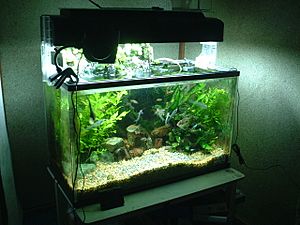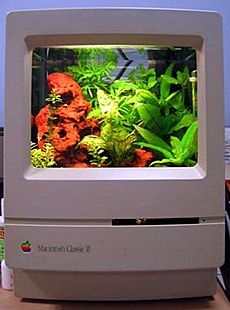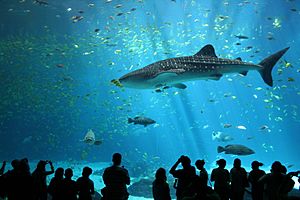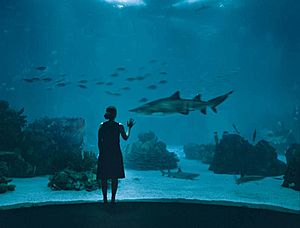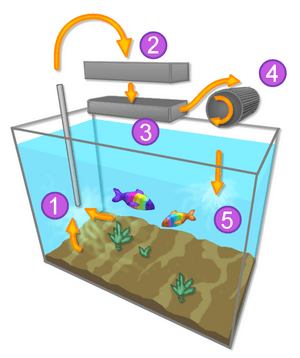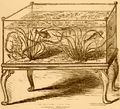Aquarium facts for kids
An aquarium is like a special home for fish and other animals that live in water. It can be a small tank you keep at home or a huge building with giant tanks, like a public zoo for water creatures.
Many people around the world enjoy keeping aquariums as a hobby. These careful aquarists (that's what people who keep aquariums are called) make sure their fish live in an environment that's very much like their natural habitat. This means they pay close attention to the water quality, the lighting, and the food their fish eat.
Large public aquariums are often popular places for tourists to visit. They show off amazing fish and other water animals in huge tanks. These places also often help protect species that are close to extinction. A famous example is the Sydney Aquarium in Australia.
Contents
Design
Aquariums come in many shapes and sizes, from small bowls to massive tanks.
Materials
Most home aquariums are made from glass panels glued together with a special type of silicone. They often have plastic frames around the top and bottom for decoration. Glass aquariums are very common for sizes up to about 1000 litres (250 gallons).
The very first modern glass aquarium was created in the 1800s. Back then, they often had slate or steel bottoms and were sealed with putty. Modern aquariums use silicone, which is much better. Acrylic aquariums also exist and are a main competitor to glass. Acrylic tanks are stronger and much lighter than glass. They can also be shaped in more interesting ways.
However, glass aquariums are usually cheaper and don't scratch as easily as acrylic ones. Glass also doesn't turn yellow over time, which acrylic can do. For very large tanks, the price difference between glass and acrylic often disappears.
Styles
People have gotten very creative with aquarium designs! You can find aquariums built into coffee tables, sinks, and even old Apple Macintosh computer shells, which are called MacQuariums. Some new aquariums even have space for air-breathing pets like cats or hamsters. For wealthy people, huge, custom-designed home aquariums have become a way to show off.
A special type of aquarium called a kreisel tank is designed for delicate animals like jellyfish. These tanks have a slow, circular water flow and very few things inside, so the jellyfish don't get hurt by pumps or tank parts. They have no sharp corners and keep the animals gently suspended in the water.
Another popular style is the biotope aquarium. This type tries to perfectly recreate a specific natural environment, like a part of the Amazon River or Lake Malawi. Everything in the tank – the fish, plants, rocks, and wood – matches that natural place. It can be quite a challenge to make a true biotope aquarium!
Aquarium size and volume
Aquariums can be tiny, like a small glass bowl, or enormous, like public aquariums that hold entire kelp forests. Generally, larger home aquariums are more stable. They resist quick changes in temperature and water chemistry, which helps keep the fish healthy. The bigger the tank, the easier it is for the system to handle small problems, like a fish dying. This is why many hobbyists prefer larger tanks, as they need less constant attention.
Small, unfiltered fish bowls are generally not good for most fish. Modern aquariums need good filtration systems to keep the water clean.
Most home aquariums are limited in size by their weight (water is heavy!) and the water pressure on the glass. A 1 cubic meter tank (about 1,000 liters) weighs 1,000 kilograms (2,200 pounds)! Some dedicated aquarists build tanks much larger than this.
Public aquariums, designed to show off huge species, can be much, much bigger. For example, the Georgia Aquarium has a tank that holds over 6 million gallons of water!
Components
A typical home aquarium usually has a few key parts:
- A filtration system to keep the water clean.
- An artificial lighting system.
- A heater or chiller to control water temperature.
Many aquariums also have a hood or lid. This helps stop water from evaporating and prevents fish from jumping out (or other things from falling in!). Lids often hold the lights too.
Filtration systems are very important. They help remove waste and keep the water safe for fish. Some filters use special materials that house tiny microbes which help clean the water.
Aquarium heaters have a heating part and a thermostat to keep the water at the right temperature. Coolers or chillers are used if the room is too warm for the fish that need colder water. Thermometers help you check the temperature. Some aquarists also use air pumps with airstones or water pumps to move the water around. This helps add oxygen to the water.
The way an aquarium is set up physically also matters. The size of the tank, the lighting, how many plants there are, where rocks and wood are placed, and the type of gravel or sand can all affect how the fish behave and survive.
Because aquariums are so heavy, they need a strong, level stand. A stand that isn't level can cause the tank to crack or leak. Many stands have cabinets for storage and come in different styles to match a room's decor.
Aquarium maintenance
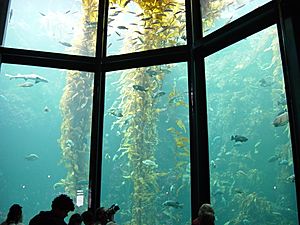
Aquariums need regular care to keep the fish healthy. Daily tasks include checking the fish for any signs of stress or disease.
Water conditions
The stuff dissolved in the water is super important because it affects the water's chemistry and how the animals live. One basic measure is salinity, which is how much salt is in the water.
- Freshwater aquariums (very little salt) are like lakes or rivers.
- Brackish water aquariums (some salt) are like estuaries, where fresh and salt water mix.
- Saltwater aquariums (lots of salt) are like the ocean.

Most home aquarists use tap water. If your tap water has chlorine or chloramine (which many do), you need to add special liquids called dechlorinators to make it safe for fish. For brackish or saltwater tanks, you also need to add special salt mixtures.
Water temperature is another key factor. Most fish and plants can only live in a certain temperature range. Tropical aquariums, usually around 25°C (77°F), are the most common. Cold water aquariums are for fish that like cooler temperatures. It's more important for the temperature to stay steady than to be a specific number, because sudden changes can shock fish and make them sick.
Nitrogen cycle
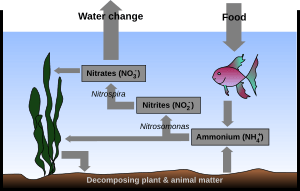
One of the most important things for an aquarist to manage is the waste produced by the animals in the tank. Fish, other animals, and even some bacteria create nitrogen waste, mainly in the form of ammonia. Ammonia is also made when plants and animals decompose (break down). High levels of ammonia are toxic to fish.
The process
A healthy aquarium has tiny organisms that can break down these waste products. This process is called the nitrogen cycle.
- Special Bacteria called nitrifiers (like Nitrosomonas) eat the ammonia and turn it into nitrite. Nitrite is also harmful to fish in large amounts.
- Other bacteria (like Nitrospira) then turn the nitrite into nitrate. Nitrate is much less harmful to fish, especially at lower levels.
- Aquatic plants also help by using nitrate as food, which removes it from the water.
- Regular water changes are also needed to remove nitrates and other waste that builds up.
Aquarium supplies
To keep an aquarium clean and healthy, you'll need specific cleaning supplies. These can include:
- Special cleaning liquids for the water.
- Nets for catching fish or removing debris.
- Algae magnets and scrapers to clean the glass.
- Gravel cleaners to vacuum the bottom.
- Brushes and tongs for reaching inside.
Regular cleaning makes sure your fish are healthy and happy, and that your tank looks good!
Water clarifiers can help if the water gets cloudy from too much waste. However, if your water is often cloudy, it might mean your filters aren't working well and need to be cleaned or replaced. You can also use algaecides to control too much algae or cyanobacteria.
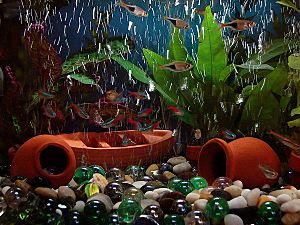
Other factors affecting capacity
The number of fish an aquarium can hold depends on several things. Smaller fish often need more oxygen per body weight than larger fish. Some fish, like Labyrinth fish, can breathe air from the surface, so they don't need as much oxygen in the water.
The surface area of the water is important because that's where oxygen enters the tank. Moving the water surface, like with an air pump, helps more oxygen get into the water.
Waste also uses up oxygen as it breaks down. Warmer water holds less oxygen, which can be a problem because fish are more active in warmer water and use more oxygen.
Public aquaria
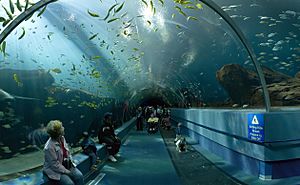
Most public aquariums have many smaller tanks, plus huge ones that are too big for homes. The biggest tanks can hold millions of gallons of water and house very large animals like sharks or beluga whales. Some places, called dolphinaria, are specifically for dolphins. Public aquariums might also keep other water-loving animals like otters and penguins. They can be part of larger places like marine mammal parks.
Virtual aquariums
A virtual aquarium is a computer program that creates an aquarium on your computer screen using 3D graphics. The fish swim around in real time, while the background of the tank usually stays still.
Images for kids
-
The underwater tunnel in the London aquarium
-
An aquarium of the 1850s containing Vallisneria spiralis and coldwater fish from Shirley Hibberd's The Books of the Aquariums and Waters Cabinets. London
-
The Jardin zoologique at the Bois de Boulogne included an aquarium that housed both fresh and saltwater animals, 1860 in Paris.
-
Pike in an aquarium c. 1908, at the Belle Isle Aquarium, Belle Isle Park
-
An aquarium in the Burj Al Arab in Dubai
-
A 1,200,000-litre (320,000 US gal; 260,000 imp gal) aquarium at Monterey Bay Aquarium in California, displaying a kelp forest ecosystem
-
Live plants in an aquarium utilize the final product in the nitrogen cycle of nitrate as fertilizer, helping the nitrate levels stay minimal. This 60-litre aquarium contains Anubias barteri and Echinodorus bleheri. A heater and small filter are in the background.
-
A saltwater aquarium
See also
 In Spanish: Acuario (recipiente) para niños
In Spanish: Acuario (recipiente) para niños


